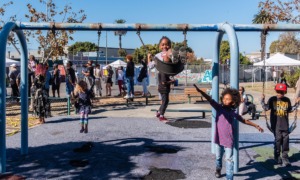Author(s): Juvenile Law Center
- Jessica Feierman
- Karen U. Lindell
- Natane Eaddy
Published: Aug. 2, 2017
Report Intro/Brief:
“The American criminal justice system adopted the use of solitary confinement in the mid-1800’s as a means to “inspire true regret in the hearts of convicts.” But the practice of holding individual prisoners alone in their cells ostensibly to promote rehabilitation quickly raised constitutional and humanitarian concerns, and the experiment failed. Almost immediately, jails and prisons that had adopted the practice began reporting widespread mental health consequences; early studies raised similar concerns. Indeed, as early as 1890, the United States Supreme Court granted relief to a death row inmate subjected to solitary confinement, citing studies showing that prisoners exposed to isolation, even for a short time, often fell into “a semi-fatuous condition,” “became violently insane,” or committed suicide.
And yet, more than 125 years later, the United States still routinely subjects some of the most vulnerable members of our society—youth involved in the juvenile justice system—to the harmful effects of solitary confinement. In the century since the Supreme Court first expressed concerns about the practice, our understanding of its harms—particularly for youth—has only grown. Research confirms that youth are uniquely vulnerable and that they are at a heightened risk of long-term harm from time spent in solitary confinement. Many correctional experts now agree that solitary confinement is counterproductive to the aims of the juvenile justice system, and there is a growing consensus among medical professionals and correctional administrators that solitary confinement of children must end. Policymakers in many states have responded, imposing significant restrictions on the practice, and in 2016 President Obama banned the use of solitary confinement for youth in federal prisons.
Despite this progress at the federal level and in a growing number of states, solitary
confinement of youth remains widespread, with a disproportionate impact on youth of color (predominantly Black and Latinx youth), gender non-conforming youth, LGTBQ youth, and youth with disabilities. Moreover, we still lack comprehensive data on the use of solitary confinement in juvenile facilities, sufficient information about effective alternatives, and input from youth, families, and the communities most affected. This report relies on legal research, psychological research, surveys of public defenders and state protection and advocacy agencies, and conversations with youth, families, and advocates to fill those gaps and to offer recommendations for reform.
Although this report focuses on reforms within facilities, it is worth noting that the most effective way to end the practice is to keep youth at home with their families and in their communities, providing quality supports and services when necessary. Moreover, as described throughout the report, thoughtful partnerships with families, community members, and other advocates can help align efforts to end solitary confinement with broader deincarceration efforts.
Our reform recommendations include:
■ Policy Reforms:
– Ensure that policies prohibit, rather than alter or ameliorate, solitary confinement. Reform must include a ban on solitary confinement for any reason other than to prevent immediate harm, with clear limits on its use even under
emergency circumstances; a clear definition of the term; support for positive
alternatives and de-escalation tactics; and requirements for data collection.
■ Litigation Strategies:
– Argue for a doctrinal analysis under the Eighth or Fourteenth Amendments that incorporates current scientific research regarding children and adolescents, rather than parroting the adult constitutional analysis. Several recent solitary confinement cases have successfully relied upon the series of decisions from the Supreme Court recognizing the effect of adolescent development research on constitutional standards.
– Bring education claims in support of ending solitary confinement. Claims
challenging the failure to provide a meaningful education can be a key part of
litigation seeking to end solitary confinement. However, the goal must be to
get youth out of solitary confinement, not to improve the conditions by adding
educational opportunities to youth in room restriction, and litigation strategies
must all support this ultimate goal.
– Challenge discriminatory policies and practices. Federal disability law can offer a
more protective standard than classic conditions of confinement claims, and other
discrimination claims should be considered when appropriate.
■ Strong Juvenile Defense:
– Ensure post-disposition representation. Many, if not most, uses of solitary
confinement in juvenile facilities occur post-adjudication in juvenile correctional
facilities, making post-dispositional representation an essential advocacy strategy.
– Ask targeted questions. Youth and families may not immediately share information
about harsh conditions of confinement unless defenders ask specific questions and
invite discussion on the issue.
– Visit local facilities. By visiting their clients’ placements, witnessing conditions,
and reviewing facility records, defenders can better advocate for clients and can
also serve as a vital source of information to other stakeholders and advocates.
– Enlist the court. Raising constitutional and statutory challenges to solitary
confinement in individual cases can be an effective form of advocacy, and court
orders can assist in getting youth appropriate services or supports.
– File licensing complaints and grievances. By reporting uses of solitary
confinement that may violate facility policy, licensing requirements, or other
regulations, advocates create a written record of the problem and can potentially
prompt an investigation or other responsive action.
– Work with advocates engaged in system reform. By partnering with other
organizations, such as the local Protection & Advocacy (P&A) agency, defenders
can expand the resources available to challenge uses of solitary confinement.
■ Community Partnerships:
– Work with youth, parents, and other community advocates. Such collaborations
are essential to any reform effort. Community groups can help defenders, litigators,
and policy advocates identify abuses, shape the broader reform effort, and elevate
issues not easily presented as legal arguments.”




























